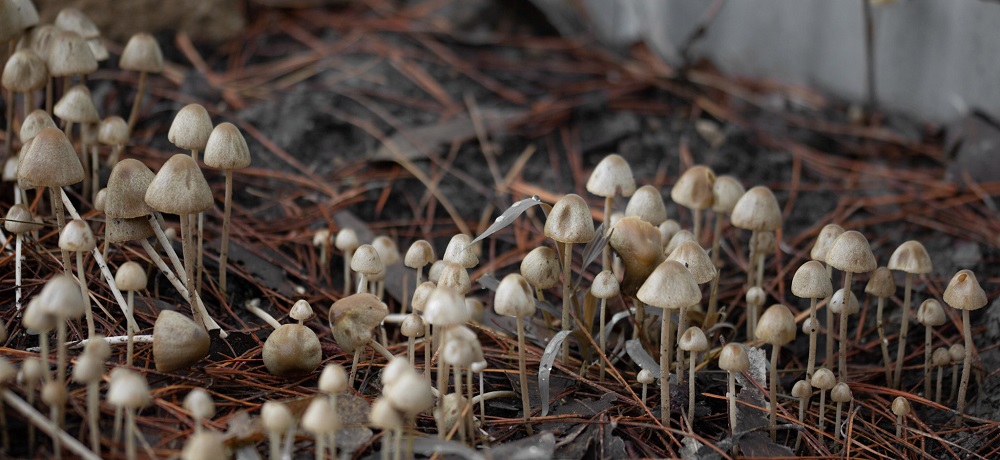IT’S MUSHROOM SEASON AND LOCAL HIKERS ARE DISCOVERING SOME FASCINATING TROVES. GO TO THE COMMENTS SECTION AT THE END OF THIS PIECE AND IDENTIFY THESE MUSHROOMS IF YOU CAN AND WHETHER THEY ARE EDIBLE OR NOT.
As a result of January’s rains, mushrooms of every size and shape are appearing throughout the Santa Monica Mountains. Just like wildflowers, mushrooms only appear in large numbers during a wet year, but the fungi that produces them is at work year round, in the earth, or in decaying wood and other vegetation. When conditions are favorable, mushrooms, the “fruit” of the fungi appear, spreading spores during the brief period of favorable conditions, before disappearing once more into the earth.
Mushroom and lichens are thought to be among the most diverse, widespread and numerous organisms in the local mountains.
Local species range from highly prized edible mushrooms, including chanterelles and morels, to highly toxic species like Amanita ocreata, the “destroying angel,” and Omphalotus olivascens, the Western “Jack o’ Lantern,” not deadly, but toxic enough to make anyone who eats it by mistake very sick indeed.
Mycorrhizal fungi have a symbiotic relationship with trees like live oaks. The mushrooms produced by this type of fungi grows exclusively where its host trees grow. Other types of fungi are not tethered to trees, but grow in the soil. The kind of fairy ring mushrooms that appear in lawns or fields are a common example of this type of saprotropic mushroom.
There are around 60 known species of fairy ring mushrooms, both tethered and untethered. The name comes from the European myth that these rings grow where supernatural beings have danced. Tradition says the rings are full of magic, and that stepping into them can change a mortals luck, for good or ill.
This type of mushroom really does have a miraculous power: the ability to deposit chemicals that can kill the grass they grow out of or act as growth hormone generating lush and rapid growth of grass once the mushrooms have finished their life cycle.
Calvatia cyathiformis stimulates grass to grow abundantly; Leucopaxillus giganteus causes it to die. Both species leave a ring behind long after the mushrooms have vanished.
Although fairy ring mushrooms are ephemeral, appearing for only a few days following a rain, the fungi that produce them can reportedly live for hundreds of years. A 1982 paper by researcher P.H. Gregory published in “The Bulletin of the British Mycology Society,” found an example of the fairy ring mushroom species Infundibulicybe geotropa in Belfort, France, that was 2,000 feet in diameter and estimated to be over 700 years old.
Mushrooms are a fascinating part of a wet winter in the Santa Monica Mountains, but eating them can be problematic, even for experts.
Most mushrooms should be cooked before eating. Some species, including morels, are only edible cooked.
Although incidents grab headlines, and mushrooms crop up in murder mysteries and crime dramas, fatalities from eating poison mushrooms are relatively rare—a total of five in California between 2010 and 2015, and 57 additional incidents of severe poisoning that did not result in death but required hospitalization. Gastrointestinal upset from eating the wrong type of mushroom is estimated to be much more common. While unpleasant, it is unlikely to be lethal, but it can still be debilitating.
Experts urge would-be mushroom hunters not to rely on apps or field guides, but to make absolutely certain they have collected an edible species.
Pet owners and parents with young children are encouraged to make sure mushrooms aren’t sprouting in play areas. One “destroying angel” mushroom cap is enough to kill a human being or a dog, and this mushroom is easily mistaken for innocuous common white garden mushrooms, but there are plenty of other species that can make a child, dog, or inattentive mushroom forager ill.
There are also mushrooms growing wild that sell for their weight in gold in gourmet shops, and mushrooms that reward the observer with the sight of an amazing array of shapes and colors—but only in a wet year, and only for a few days after the rain.
Anyone interested in learning more about wild mushrooms should check out the Los Angeles Mycological Society’s Wild Mushroom Fair, Sunday, February 10, 9 a.m.-4 p.m. at the Los Angeles County Arboretum and Botanic Garden, 301 North Baldwin Avenue Arcadia, CA, 91007. For more information visit: lamushrooms.org


I thought by going online I would get the answers to the types of mushrooms shown in the photos but were not yet identified at time of printing.
So far we haven’t had any responses to our requests for identification. Here’s a link to an interesting article about “death cap mushrooms. Thankfully, none of our photographers seems to have come across this type.
https://www.theatlantic.com/science/archive/2017/06/death-cap-poisonings/530028/
Here is a response from mycologist Florence Nishida with respect to the 5th photo above in the gallery: “From your photo, I can’t be sure whether the hymenium (the underside) of the mushroom is smooth, or has tiny pores. If smooth, it would be Stereum hirsutum, but if it is poroid, it would be Trametes versicolor. The stereum is also thinner than the trametes. So, I think your fungus is likely Stereum hirsutum.”
Another name for stereim, according to Wikipedia is “False Turkey Tail”. Trametes is referred to as “Turkey Tail”.